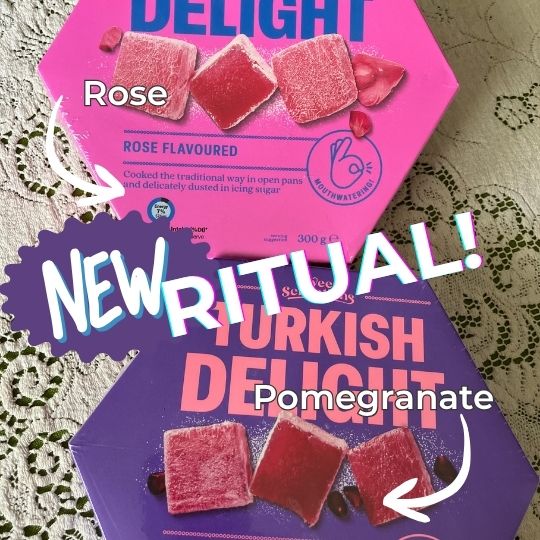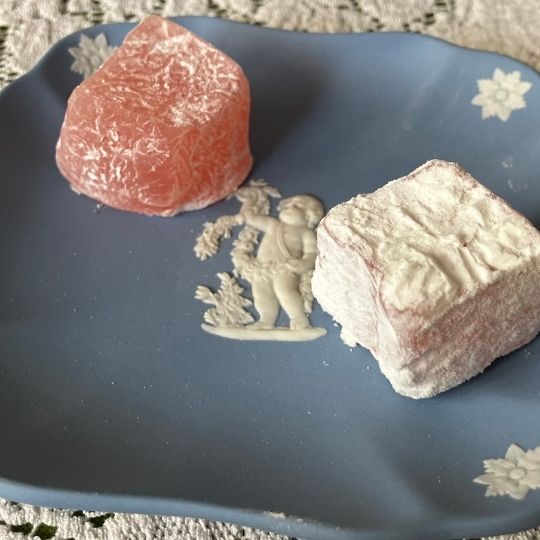Sweet Wedding Rituals
Categories: | Wedding Ceremony | Wedding Rituals |
 The
giving of sweet things is a common wedding celebration
custom - think of the Greek and Italian custom of
giving guests five sugar-coated almonds wrapped up in
tulle, five being an indivisible number, or the Dutch
bride sugar, also five lollies (I like barley sugar
for this because it is a nice bright orange), and the
common Australian wedding custom of giving chocolates
or cookies for favours.
The
giving of sweet things is a common wedding celebration
custom - think of the Greek and Italian custom of
giving guests five sugar-coated almonds wrapped up in
tulle, five being an indivisible number, or the Dutch
bride sugar, also five lollies (I like barley sugar
for this because it is a nice bright orange), and the
common Australian wedding custom of giving chocolates
or cookies for favours. Going one step further and incorporating a sweet ritual in your ceremony, using either honey or sugar, can add a symbolic richness that really speaks to the hearts of your guests.
Honey Ceremony
The honey ritual, in which the marrying
couple each dip their pinky into a dish of honey is
a very symbolic act which is steeped in Persian
roots, but commonly observed in other Islamic
traditions too.
In Ancient Egypt, honey bees were regarded to be a symbol of royalty. Honey bees were associated with Eros/Cupid, the god of love, in Ancient Greece and Rome. He is often shown dipping his fingers into honey in art works of the Renaissance period. And the Hindu god, Kama, the god of love, like Cupid has a bow and arrow. His bowstring is made up of bees. And, very apt for marriage, bees provide an excellent example of teamwork, and of working unceasingly for the common good.
Honey in itself is powerfully symbolic of so much of what we wish for a marrying couple. Because it is not hospitable to bacteria, tt never spoils. Honey found in Egyptian tombs proved to be still edible thousands of years later. It has healing properties. The characteristics of an individual pot of honey depend very much on what goes into it - which flowers the bees sourced the pollen from, just as each marriage is uniquely influenced by the input of the couple. It is nourishing. And it is sweet. So when we use honey in a ceremony it represents the sweetness of wisdom in Shamanism, and the sweetness of life, as referenced in the words of the great Persian poet, Rumi
In Ancient Egypt, honey bees were regarded to be a symbol of royalty. Honey bees were associated with Eros/Cupid, the god of love, in Ancient Greece and Rome. He is often shown dipping his fingers into honey in art works of the Renaissance period. And the Hindu god, Kama, the god of love, like Cupid has a bow and arrow. His bowstring is made up of bees. And, very apt for marriage, bees provide an excellent example of teamwork, and of working unceasingly for the common good.
Honey in itself is powerfully symbolic of so much of what we wish for a marrying couple. Because it is not hospitable to bacteria, tt never spoils. Honey found in Egyptian tombs proved to be still edible thousands of years later. It has healing properties. The characteristics of an individual pot of honey depend very much on what goes into it - which flowers the bees sourced the pollen from, just as each marriage is uniquely influenced by the input of the couple. It is nourishing. And it is sweet. So when we use honey in a ceremony it represents the sweetness of wisdom in Shamanism, and the sweetness of life, as referenced in the words of the great Persian poet, Rumi
And if you would like to enhance the symbolism, a little effort will deliver rose-flavoured honey, adding another universal symbol of love.In companionship and happiness
may you be like milk and honey
in union and fidelity
Recipe: Bring a cup of mild-flavored honey to a boil in a heavy saucepan. Turn off the heat as soon as the honey starts to foam up. Stir in a half cup of fresh rose petals (make sure they are organic and well-washed). Let the mixture sit for four hours. Bring to a boil again. Pour through a strainer and discard the petals.Some practicalities for a honey ceremony
- You won't need much honey, but you will need to have it in a container (jar, glass, or dish) that allows the honey to be visible to your guests (I prefer glass), that can be presented without risk of spilling, and that can be covered (if outside) to keep flies and bees away.
- choose thicker honey (in a jar) rather than
thinner honey in a squeeze bottle
- you can feed one another one at a time, which I prefer as it is more dramatic when the honey is presented to each of you in turn, or you can scoop up the honey simultaneously and feed it to one another at the same time.
- Have some wet wipes discreetly handy!
Sugar Sealing
A rather lovely Sephardi custom is for the
couple to eat sugar under the chuppah. Prior to her
real-life wedding Mayim Bialik (Amy in Big Bang
Theory) and her parents observed the Indian Jewish
custom of the bride's parents placing sugar on the
bride's tongue for good luck after the signing of
the legal engagement contract. This could be
expanded to include the parents of both of you, and
could be integrated with a parental blessing.
Persian aghd
ceremony
The Sofreh Aghd, a spread consisting of
multiple symbolic items representing an element of
the couple's new life together, is an Iranian
cultural tradition with roots stretching back into
Persian history. After the legal proceedings are
concluded, the aghd ceremony begins with
happily married ladies holding a white cloth over
the heads of the bride and groom while another rubs
two kallehqand (large loaves of
sugar) over the couple's head to symbolise the
raining down of sweet joy and happiness on the
couple. The photos below are of two
intercultural weddings where, in each case, we
incorporated the groom's Persian Zoroastrian
marriage customs, including the sugar ritual

A New Ritual Developed by
Me - Turkish Delight (Added 2025)
 I
love authentic Turkish Delight. So, to me, it is an
obvious way to ramp up and give a modern,
multi-cultural twist to the simple age-old sugar and
honey rituals of the marrying couple sharing
something sweet as an expression of wishes for a
sweet life together.
I
love authentic Turkish Delight. So, to me, it is an
obvious way to ramp up and give a modern,
multi-cultural twist to the simple age-old sugar and
honey rituals of the marrying couple sharing
something sweet as an expression of wishes for a
sweet life together.
Drawing on universal symbolism of Roses (Love) and Pomegranate (Marriage and Fertility) it comes together beautifully, and with immense depth.
But that's all I'm sharing. A unique ritual, reserved only for my couples. Courtesy of a creative imagination (mine) drawing on wide reading and knowledge of wedding traditions.
Thanks for reading!

Persian aghd
ceremony

A New Ritual Developed by
Me - Turkish Delight (Added 2025)
 I
love authentic Turkish Delight. So, to me, it is an
obvious way to ramp up and give a modern,
multi-cultural twist to the simple age-old sugar and
honey rituals of the marrying couple sharing
something sweet as an expression of wishes for a
sweet life together.
I
love authentic Turkish Delight. So, to me, it is an
obvious way to ramp up and give a modern,
multi-cultural twist to the simple age-old sugar and
honey rituals of the marrying couple sharing
something sweet as an expression of wishes for a
sweet life together.Drawing on universal symbolism of Roses (Love) and Pomegranate (Marriage and Fertility) it comes together beautifully, and with immense depth.

But that's all I'm sharing. A unique ritual, reserved only for my couples. Courtesy of a creative imagination (mine) drawing on wide reading and knowledge of wedding traditions.
Thanks for reading!
